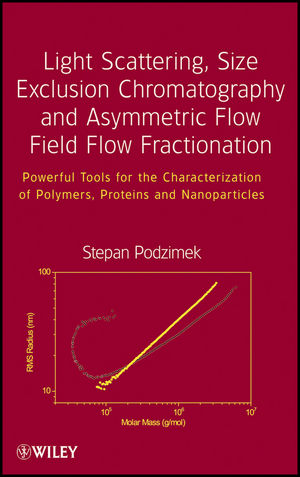Light Scattering, Size Exclusion Chromatography and Asymmetric Flow Field Flow Fractionation: Powerful Tools for the Characterization of Polymers, Proteins and NanoparticlesISBN: 978-0-470-38617-0
Hardcover
372 pages
June 2015
 This is a Print-on-Demand title. It will be printed specifically to fill your order. Please allow an additional 10-15 days delivery time. The book is not returnable.
|
||||||
1 Polymers.
1.1 Introduction.
1.2 Molecular Structure of Polymers.
1.2.1 Macromolecules in Dilute Solution.
1.3 Molar Mass Distribution.
1.3.1 Description of Molar Mass Distribution.
1.3.1.1 Distribution Functions.
1.3.1.2 Molar Mass Averages.
1.4 Methods for the Determination of Molar Mass.
1.4.1 Method of End Groups.
1.4.2 Osmometry.
1.4.2.1 Vapor Pressure Osmometry.
1.4.2.2 Membrane osmometry.
1.4.3 Dilute Solution Viscometry.
1.4.3.1 Properties of Mark-Houwink Exponent.
1.4.3.2 Molecular Size from Intrinsic Viscosity.
1.4.3.3 Dependence of Intrinsic Viscosity on Polymer Structure, Temperature and Solvent.
1.4.4 Matrix Assisted Laser Desorption Ionization Time-of-Flight Mass Spectrometry.
1.4.5 Analytical Ultracentrifugation.
1.5 Keynotes.
1.6 References.
2 Light Scattering.
2.1 Theory and Basic Principles.
2.2 Types of Light Scattering.
2.2.1 Static Light Scattering.
2.2.1.1 Particle Scattering Functions.
2.2.1.2 Light Scattering Formalisms.
2.2.1.3 Processing the Experimental Data.
2.2.2 Dynamic Light Scattering.
2.3 Light Scattering Instrumentation.
2.4 Specific Refractive Index Increment.
2.5 Light Scattering in Batch and Chromatography Mode.
2.6 Parameters Affecting Accuracy of Molar Mass Determined by Light Scattering.
2.7 Examples of Light Scattering Measurement in Batch Mode.
2.8 Keynotes.
2.9 References.
3 Size Exclusion Chromatography.
3.1 Introduction.
3.2 Separation Mechanisms.
3.2.1 Steric Exclusion.
3.2.2 Restricted Diffusion.
3.2.3 Separation by Flow.
3.2.4 Peak Broadening and Separation Efficiency.
3.2.5 Secondary Separation Mechanisms.
3.3 Instrumentation.
3.3.1 Solvents.
3.3.2 Columns and Column Packing.
3.3.3 Detectors.
3.3.3.1 UV Detector.
3.3.3.2 Refractive Index Detector.
3.3.3.3 Infrared Detector.
3.3.3.4 Evaporative Light Scattering Detector.
3.3.3.5 Viscosity Detector.
3.3.3.6 Light Scattering Detector.
3.3.3.7 Other Types of Detectors.
3.4 Column Calibration.
3.4.1 Universal Calibration.
3.4.2 Flow Marker.
3.5 SEC Measurements and Data Processing.
3.5.1 Sample Preparation.
3.5.1.1 Sample Derivatization.
3.5.2 Determination of Molar Mass and Molar Mass Distribution.
3.5.3 Reporting Results.
3.5.4 Characterization of Chemical Composition of Copolymers and Polymer Blends.
3.5.5 Characterization of Oligomers.
3.5.6 Influence of Separation Conditions.
3.5.7 Accuracy, Repeatability and Reproducibility of SEC Measurements.
3.6 Applications of SEC.
3.7 Keynotes.
3.8 References.
4 Combination of SEC and Light Scattering.
4.1 Introduction.
4.2 Data Collection and Processing.
4.2.1 Processing MALS Data.
4.2.1.1 Debye Fit Method.
4.2.1.2 Zimm Fit Method.
4.2.1.3 Berry fit Method.
4.2.1.4 Random Coil Fit Method.
4.2.1.5 Influence of Light Scattering Formalism on Molar Mass and RMS Radius.
4.2.2 Determination of Molar Mass and RMS Radius Averages and Distributions.
4.2.3 Chromatogram Processing.
4.2.4 Influence of Concentration and Second Virial Coefficient.
4.2.5 Repeatability and Reproducibility.
4.2.6 Accuracy of Results.
4.3 Applications of SEC-MALS.
4.3.1 Determination of Molar Mass Distribution.
4.3.2 Fast Determination of Molar Mass.
4.3.3 Characterization of Complex Polymers.
4.3.3.1 Branched Polymers.
4.3.3.2 Copolymers and Polymer Blends.
4.3.4 Conformation Plots.
4.3.5 Mark-Houwink Plots.
4.4 Keynotes.
4.5 References.
5 Asymmetric Flow Field Flow Fractionation.
5.1 Introduction.
5.2 Theory and Basic Principles.
5.2.1 Separation Mechanisms.
5.2.2 Resolution and Band Broadening.
5.3 Instrumentation.
5.4 Measurements and Data Processing.
5.4.1 Influence of Separation Conditions.
5.4.1.1 Isocratic and Gradient Experiments.
5.4.1.2 Overloading.
5.4.2 Practical Measurements.
5.5 A4F Applications.
5.6 Keynotes.
5.7 References.
6 Characterization of Branched Polymers.
6.1 Introduction.
6.2 Detection and Characterization of Branching.
6.2.1 SEC Elution Behavior of Branched Polymers.
6.2.2 Distribution of Branching.
6.2.3 Average Branching Ratios.
6.2.4 Other Methods for the Identification and Characterization of Branching.
6.3 Examples of Characterization of Branching.
6.4 Keynotes.
6.5 References.
Symbols.
Abbreviations.
Index.



